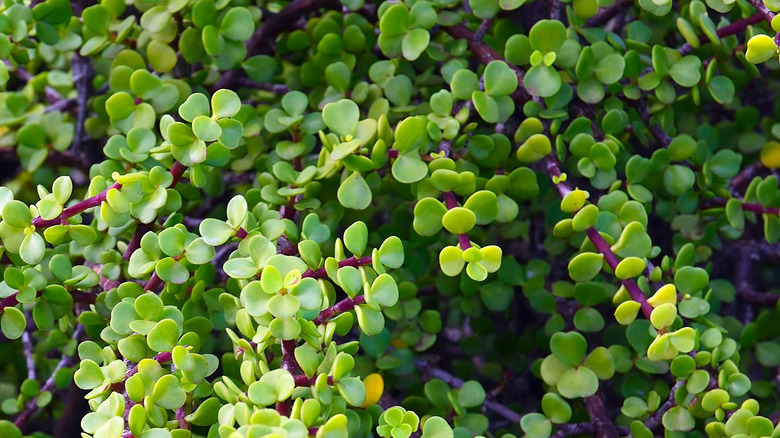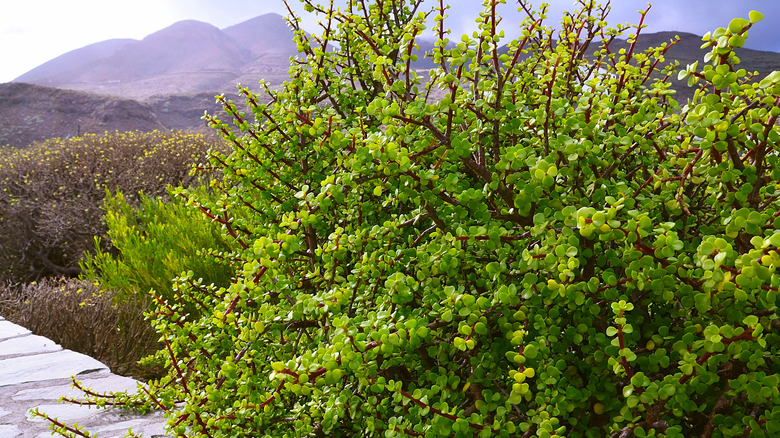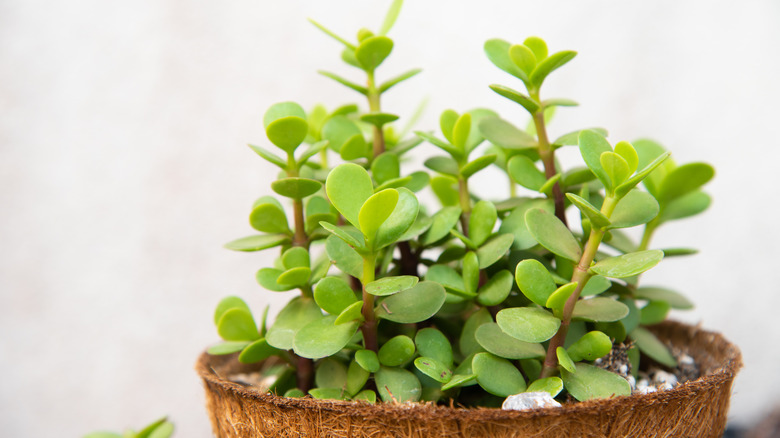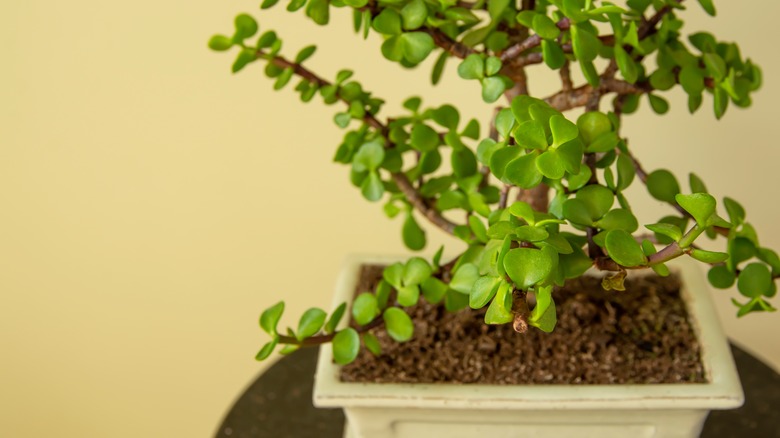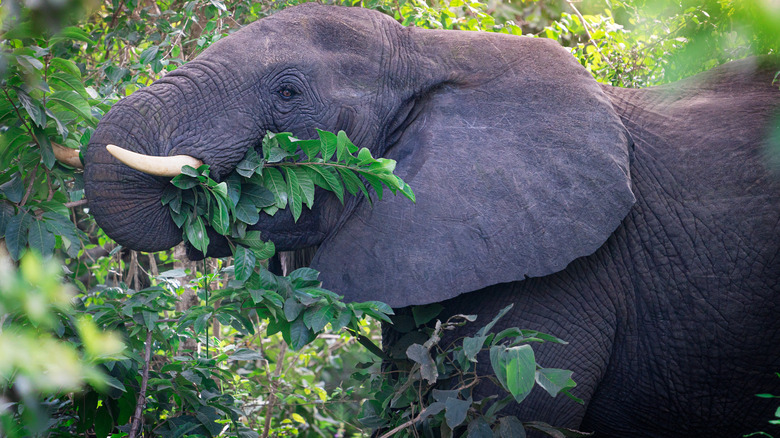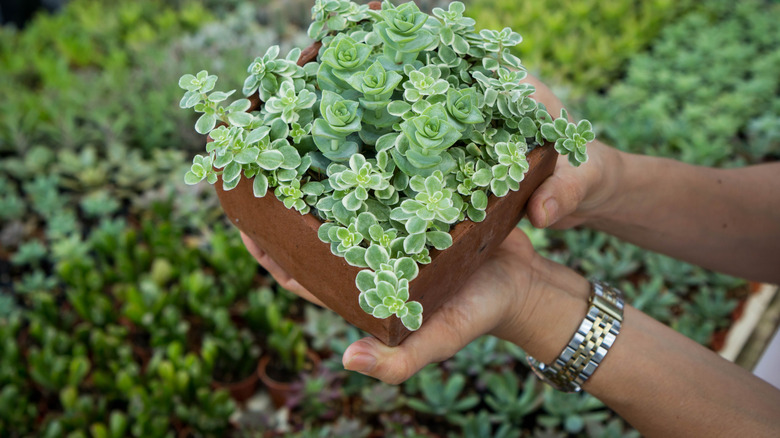Elephant Bush: Everything You Should Know Before Planting
An elephant bush (Portulacaria afra) is a perennial plant with fleshy green leaves and reddish-brown stems. While these succulents grow in USDA hardiness zones of 10 and 11, they can also thrive indoors in bright, warm rooms, as per Gardening Know How. The shrubs can reach 6 to 20 feet outdoors, but don't start to measure how tall your ceiling is yet, though. These plants usually grow only a few feet inside. The plant also works well in a hanging basket since its leaves will cascade gracefully from the planter.
The elephant bush likes well-drained, somewhat sandy soil. You want indirect sunlight if you're growing it indoors since too much of it overhead can char its leaves. Providing the right amount of water is also vital. Outside plants are drought tolerant but need their liquid in season, from April to October. You get a break in the winter months, though, since the plants become dormant and H20 sprinklings aren't necessary. When you nourish an elephant bush properly, you will be rewarded with white, pink, and purple flower clusters, according to Plant Care Today. Plus, the plant can feed people as well as animals! In South Africa, its leaves and stems flavor soups, salads, and stews. If you like the sound of growing this lovely shrub, then read ahead to learn everything you should know before planting.
How to grow an elephant bush
Temperature is important with the elephant bush; there's a reason it first lived in South Africa. If the place you live offers temperatures higher than 30 degrees Fahrenheit, you can plant outside. Otherwise, these succulents make excellent houseplants. The succulent is slow to grow and won't overwhelm other elements in your garden. It will typically spread 1 to 2 feet, and less if you prune it regularly. If you wish your elephant bush to become full-sized, make sure that its perimeter has 2 feet of space. Be patient, though, because, like the slow-moving animals that feed on it, the plant's growth cycle is unhurried. You can put some small plants around it to fill the space as it grows, but be sure to transplant them as the area gets crowded, as per Plant Addicts.
Start by creating the perfect soil to foster the elephant bush when planting. Since the plant comes from a habitat with desert-like attributes, you'll need loose gravely soil that drains well. Consider getting unglazed pottery if you are using a planter since it helps water evaporate faster. Using cuttings works better than seeds when planting. Give it four to six weeks to root (via GardenBeast).
How to care for elephant bushes
The elephant bush enjoys full or partial sun, but be careful indoors of providing too much direct light, which causes damage to the leaves. About six hours of sunlight is more than enough. When it's hot, the elephant bush needs water even though it's drought tolerant. But when the weather cools, you can relax a bit. According to Plant Care Today, overwatering won't help this plant, so be sure that the soil is a bit dry before watering again.
You can even wait until you see the plant's base leaves wilting, according to GardenBeast. Elephant bush roots are susceptible to rot, so it's important to moderate the H20 properly. Fertilizer keeps the succulent thriving as well. Plan on once-a-month feedings during the spring and summer growing seasons. You should avoid pesticide sprays and petroleum-based chemicals since they can hurt the plant, damaging its leaves. If the weather stays above 30 degrees Fahrenheit, you can move your potted plants to the great outdoors for the warmer seasons. The elephant plant likes to adjust to its surroundings, so you might find that its leaves burn slightly in the beginning. If you move your plant's location, it can also lose leaves, so don't worry if you see this happening.
Varieties of the elephant bush
The elephant bush, a perennial from South Africa, has several varieties. It sometimes is confused with jade plants (Crassula ovata) since both look alike but grow differently. They are not related in any way. Some major types are:
- Mammoth elephant bush (Portulacaria afra 'Mammoth') has leaves twice as large as the regular variety, as per San Marcos Growers.
- Rainbow elephant bush (Portulacaria afra 'Variegata') contains cream-colored leaves. It is perfect for slopes, terraces, hanging baskets, and tall pots because of its trailing stems and shrubby spread (via Succulent Plant Care).
- Elephant mat (Portulacaria afra 'Minima') is tinier than other varieties and sports refined green fronds.
- Yellow rainbow bush (Portulacaria afra 'Aurea') is similar to Minima, but its hues are yellow or chartreuse.
- Skyscraper (Portulacaria afra 'Skyscraper') is less common than other varieties and looks thin and tall.
- Cork bark (Portulacaria afra 'Cork Bark') gets its name from the roughness of the plant's stems. It is also suitable for bonsai plants, according to the Department of Horticulture at the University of Wisconsin-Madison.
Is the elephant bush toxic?
Both humans and animals can eat this plant safely. In fact, it offers medicinal properties for various minor conditions. The leaves are quite tasty, and in southern Africa, it is common to put them in salads or soups, as per the Department of Horticulture at the University of Wisconsin-Madison. The flavor they provide is slightly tart and provides malic acid in the crispy foliage (via Plants With a Purpose). Like alpha-hydroxy acid, malic acid is also found in apples and pears. It is said to offer skin regeneration, aid physical conditioning, and help prevent kidney stones, according to Verywell Health.
All kinds of animals eat the elephant bush because it stays succulent and plump no matter the heat's intensity. Besides its namesake, tortoises also adore this delicious plant. When pachyderms dine, they remove the leaves, allowing the plant to expand and form new groves called "spekboomveld."
How to repot an elephant bush plant
Repotting is best done during the plant's growing season. However, since the elephant bush takes a while to become full-sized, you won't need to repot frequently. According to Easy Succulents, resist watering the plant once you move it into a new container for about a week. The succulent needs time to adjust to its new home. You should also repot it when it's dry; if the roots are wet, you can damage the plant.
You can also propagate your elephant plant with leaf cuttings. It is important to ensure that the knife used is sterilized. Allow the stems to dry and either put them into the soil or lay them on a dirt base. With proper care, the cutting should become rooted in about a month. Ensure that you avoid putting it in direct sunlight, and give it a small amount of water when the soil becomes dry.
